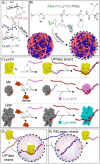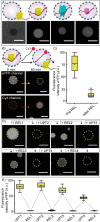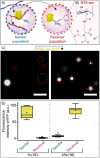DNA-Mediated Protein Shuttling between Coacervate-Based Artificial Cells
- PMID: 35133040
- PMCID: PMC9303767
- DOI: 10.1002/anie.202115041
DNA-Mediated Protein Shuttling between Coacervate-Based Artificial Cells
Abstract
The regulation of protein uptake and secretion is crucial for (inter)cellular signaling. Mimicking these molecular events is essential when engineering synthetic cellular systems. A first step towards achieving this goal is obtaining control over the uptake and release of proteins from synthetic cells in response to an external trigger. Herein, we have developed an artificial cell that sequesters and releases proteinaceous cargo upon addition of a coded chemical signal: single-stranded DNA oligos (ssDNA) were employed to independently control the localization of a set of three different ssDNA-modified proteins. The molecular coded signal allows for multiple iterations of triggered uptake and release, regulation of the amount and rate of protein release and the sequential release of the three different proteins. This signaling concept was furthermore used to directionally transfer a protein between two artificial cell populations, providing novel directions for engineering lifelike communication pathways inside higher order (proto)cellular structures.
Keywords: Coacervates; DNA; Proteins; Supramolecular Signalling; Synthetic Cells.
© 2022 The Authors. Angewandte Chemie International Edition published by Wiley-VCH GmbH.
Conflict of interest statement
The authors declare no conflict of interest.
Figures




References
Publication types
MeSH terms
Substances
LinkOut - more resources
Full Text Sources

